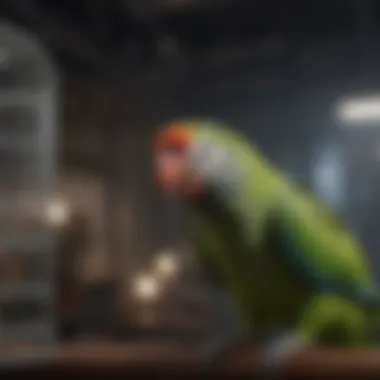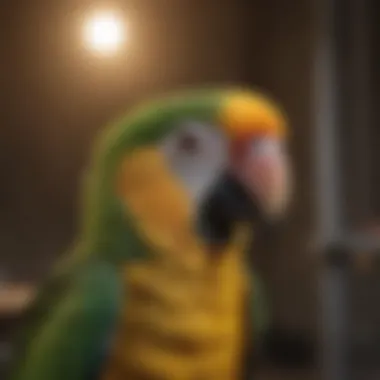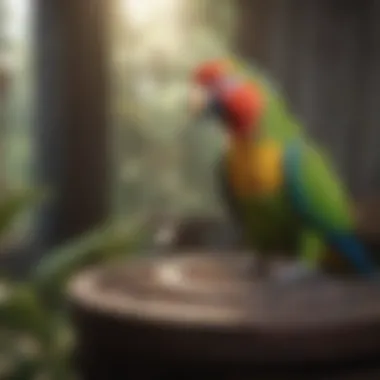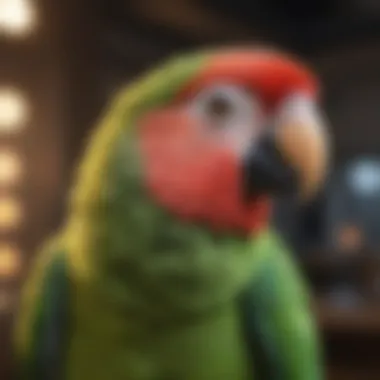Selecting the Ideal Cage for Your Ringneck Parrot


Intro
Understanding Your Pet
Pet Behavior Basics
Ringneck Parrots are curious and active birds. They require space to move around, climb, and play. Observing their natural behaviors can provide insights into their needs. They enjoy interaction and will thrive in an environment that allows for exploration and engagement.
Common Breed Characteristics
Ringneck Parrots are known for their vibrant colors and playful nature. They can develop strong bonds with their owners, showing affection and social behaviors. Their vocalizations can be varied and delightful. However, they also require significant mental stimulation to prevent boredom.
Species-Specific Needs
A suitable cage for a Ringneck Parrot must cater to its unique requirements. They need enough space to stretch their wings and move freely. Additionally, the cage should have horizontal bars for climbing and various objects to stimulate their intellect and curiosity.
Pet Care and Maintenance
Feeding Guidelines
Proper nutrition is key to a healthy parrot. A balanced diet for Ringneck Parrots includes seeds, pellets, fresh fruits, and vegetables. The diet should be varied to provide essential nutrients.
Grooming Essentials
Regular grooming contributes to the well-being of your parrot. Beak trimming, nail clipping, and feather care should become part of the routine. Teaching your Ringneck to accept handling will make grooming easier.
Hygiene Practices
Maintaining a clean cage is vital for preventing health issues. Regular cleaning of food and water dishes, as well as the bottom of the cage, should be prioritized. Safe disinfectants can be used to eliminate bacteria and parasites.
Training and Development
Basic Commands and Skills
Training your Ringneck Parrot can be rewarding. Start with simple commands such as
Understanding Ringneck Parrots
Understanding the behaviors, characteristics, and social requirements of Ringneck Parrots is critical when it comes to choosing their cage. Knowledge of these aspects can inform the choices that enhance their quality of life and overall well-being. These parrots exhibit distinct quirks, and an appreciation for these traits can prevent common pitfalls in housing practices.
Overview of Ringneck Parrots
Ringneck Parrots are small to medium-sized birds known for their vivid coloration and remarkable intelligence. Their length typically ranges from 14 to 20 inches, and they possess a long, tapering tail that distinguishes them from other species. Originating from the Indian subcontinent, their adaptability has allowed them to thrive in a variety of environments. The most recognized species is the Indian Ringneck, celebrated for its charming personality and ability to mimic sounds.
These birds are not just pretty; they require thoughtful care and a stimulating environment. Without proper attention, their natural instincts could lead to behavioral issues. Understanding their background can guide pet owners in recreating a suitable habitat, thus fostering happier and healthier companions.
Behavioral Characteristics
Ringneck Parrots display a wide range of behaviors that reflect their intelligence. Their inquisitive nature makes them enjoy exploring their surroundings, but it also means they need a variety of activities to keep them engaged. This species is known for its playful demeanor, often interacting with toys and manipulating objects. They can learn tricks and words, which adds to their dynamic personality.
Moreover, their vocalizations range from soft whistles to loud squawks. Understanding these sounds can assist owners in recognizing their mood and needs. A stressed or unhappy Ringneck will often exhibit changes in behavior, such as excessive screaming or feather plucking. It's crucial to create an environment that allows for both physical and mental stimulation to avoid such outcomes.
Social Needs
As social creatures, Ringneck Parrots thrive on interaction, either with humans or other birds. They are not solitary animals and can become bored or lonely if left alone for long periods. Hence, incorporating them into family life is beneficial. Positive interactions can include time spent outside the cage, engaging in verbal communication, and providing toys that encourage play.
If owners have multiple parrots, it's essential to monitor their interactions closely. Sometimes, even with social needs, some birds may prefer solitude or exhibit dominance behaviors. Ensuring they have their own space within the shared environment can maintain harmony. Understanding these social needs allows owners to create an enriching atmosphere that promotes well-being and reduces stress among their avian companions.
Importance of Proper Housing
Proper housing is fundamental for the well-being of Ringneck Parrots. Choosing the right cage impacts not only their physical comfort but also their emotional health. A suitable cage provides a safe space where these birds can thrive. Here, we will delve into two critical aspects of housing: physical space requirements and its impact on mental health.
Physical Space Requirements


Ringneck Parrots need ample space to move and explore. This species is naturally curious and active, which makes the size of the cage a top priority. A cramped environment can lead to various issues, such as stress or even aggression. Minimum height and width are fundamental considerations. A cage should be at least 24 inches wide and 36 inches tall for one bird. If you plan to keep multiple birds, the cage dimensions should increase correspondingly.
When assessing the physical space of the cage, consider the following aspects:
- Room for Movement: Birds need sufficient space to move their wings without hitting any surfaces. Allow them to flap and stretch freely.
- Perches and Play Areas: The cage should have different perches at various heights to encourage climbing and exploring. Adding platforms or shelves can further enhance their activity levels.
- Breathing Space: Ensure that there are enough areas within the cage for the birds to retreat to find comfort.
Using a larger cage can provide a more enriching environment, fostering natural behaviors. A proper setup encourages physical activity, which is critical for their health.
Impact on Mental Health
The mental well-being of Ringneck Parrots is intertwined with their living conditions. A well-chosen cage not only meets their physical needs but also their psychological requirements. Ringneck Parrots are intelligent creatures that require mental stimulation to prevent anxiety and boredom.
Key elements affecting their mental health include:
- Environmental Enrichment: Incorporating toys, mirrors, and climbing structures can stimulate their minds. Regularly rotating toys helps maintain their interest and prevents tedium.
- Social Interaction: This species thrives on social interaction. A properly designed cage allows them to interact with their owners and other birds, reducing feelings of loneliness.
- Calm Environment: The cage placement is important too. Position it in a common area where the bird can observe family activities, but not in a noisy or chaotic environment. This balance can create a peaceful living space, enhancing their well-being.
A well-designed cage is not just a home; it is a sanctuary where Ringneck Parrots can flourish.
In sum, the importance of proper housing cannot be overstated. It is essential for ensuring both the physical safety and the mental stimulation of Ringneck Parrots, allowing them to live vibrant, healthy lives.
Key Factors in Cage Selection
Selecting the right cage for your Ringneck Parrot is a crucial decision. It can greatly influence the well-being of the bird. Proper housing ensures enough space for movement and prevents stress and health issues. There are several key factors to consider when choosing a cage. These factors include cage size, material, and design. Taking the time to assess these elements can for sure promote a comfortable and safe living environment.
Cage Size and Dimensions
Minimum Height and Width
For Ringneck Parrots, minimum height and width are critical. A cage that is too small can result in lack of movement. Birds need enough room to stretch their wings and move around. Ideally, a minimum height of 30 inches and width of 20 inches is suggested. This dimension helps to create a space where the parrot can climb, fly short distances, and explore.
This size is beneficial because it mimics their natural habitat to some extent. Furthermore, a spacious environment leads to better mood and health. Without enough space, birds can develop behavior issues, such as feather plucking. It is also important to ensure that the cage supports multiple levels, which allows for increased activity.
Considerations for Multiple Birds
If you plan to house more than one Ringneck Parrot, size considerations take on added significance. Each bird requires adequate personal space, as overcrowding can lead to stress and aggressive behaviors. A larger cage or multiple cages could be necessary. Therefore, choosing the right dimensions becomes essential to ensure that all birds can coexist comfortably.
Unique features like multiple perches and play areas are advantageous in multi-bird situations. They promote social interaction while allowing each bird time for solitude. Balancing space requirements for multiple birds ultimately supports their physical and emotional well-being.
Cage Material
Safe Materials for Birds
Cage material plays an important role in the health of your Ringneck Parrot. Birds are sensitive to the materials they come into contact with. Opting for powder-coated metal or stainless steel is optimal. These materials are durable and safe, ensuring they do not chip or rust easily. This selection helps to reduce the risk of ingesting harmful substances.
One key characteristic of safe materials is their non-toxicity. Choosing cages made from safe materials means you can protect your bird from accidental harm. This choice empowers pet owners in making informed decisions about their bird’s habitat, ultimately contributing to a healthier lifestyle for their parrot.
Avoiding Toxic Substances
Avoiding toxic substances in cage manufacturing is paramount for protecting your parrot. Common materials, like untreated wood or cages coated with lead-based paint, are hazardous. These can release harmful chemicals over time, which can be detrimental to the bird’s health.
Being aware of potential hazards enriches the purchasing decision. It becomes vital to research brands that prioritize safety. By avoiding such substances, pet owners safeguard the health of their avian companions and reduce the risk of chronic health issues.
Cage Bar Spacing
Appropriate Spacing for Safety
Cage bar spacing is another critical factor in cage selection. Bars that are too far apart can allow birds to escape, leading to dangerous situations. Generally, a spacing of 1/2 to 3/4 inches is recommended for Ringneck Parrots. This measurement keeps the bird secure while allowing natural movement.
Safety is a benefit of suitable bar spacing. Closely spaced bars can prevent accidents, such as getting heads stuck in the bars, leading to potential injury.
Monitoring Possible Escapes
Monitoring possible escapes is a continuing responsibility for bird owners. Even if the cage bars are appropriately spaced, some parrots are particularly clever and can manage to escape through small gaps. Thus, ensuring the cage has secure latches and lock mechanisms is important.


Being proactive by regularly inspecting your cage for loose bars or latches reduces risks. This vigilance contributes to a safer environment and minimizes the potential for unexpected adventures outside the cage.
Cage Design Features
The design features of a cage for your Ringneck Parrot significantly impact its comfort and well-being. An appropriate cage design incorporates elements that ensure safety, accessibility, and enrichment. Selecting the right design can enhance the quality of life for your bird while simplifying the owner's maintenance duties.
Access Doors and Accessibility
Ease of Access for Cleaning
One of the critical aspects of ease of access for cleaning is how simple it is to enter the cage. A well-designed access door allows owners to clean and maintain the environment without stress. This feature is beneficial in maintaining hygiene, which is necessary for the health of the bird. Many cages now come with large doors or multiple access points, making it easier to reach every corner and surface.
- Key Characteristic: Large or multiple doors that allow full reach.
- Popular Choice: Cages that facilitate cleaning can greatly reduce the time and effort involved in maintenance.
- Unique Feature: Some cages have removable trays for easy disposal of waste, making the process quicker.
However, it is essential to ensure that these doors also close securely, preventing accidental escapes.
Designs for Bird Safety
Safety is paramount when it comes to cage design. Designs that prioritize bird safety often incorporate rounded edges and secure locking mechanisms.
- Key Characteristic: Safety locks that prevent accidental opening and escape.
- Beneficial Choice: These designs help assure pet owners that their birds remain safe even when unsupervised.
- Unique Feature: Some cages include double-lock systems or locks that require two actions to open, ensuring security.
However, always check for gaps or openings where a curious bird might escape.
Perches and Hanging Accessories
Types of Perches
The types of perches placed in the cage directly impact your bird's comfort and health. It is advisable to select a variety of perches made from natural materials to encourage natural behavior. Various textures and diameters are vital for foot health, allowing birds to exercise their feet properly.
- Key Characteristic: Natural wood perches as opposed to plastic ones.
- Popular Choice: Different types of materials provide stimulation as birds can grip and maneuver around easily.
- Unique Feature: Some perches come with added features like sisal, which encourages your bird to engage in natural chewing behavior.
Opting for removable perches can also facilitate easy cleaning and replacement when necessary.
Placement for Natural Behavior
Where you place the perches matters significantly for placement for natural behavior. The strategic positioning of perches allows your Ringneck Parrot to engage in climbing, stretching, and exploring, mimicking its natural habitat.
- Key Characteristic: Height variation creates opportunities for different activities such as flying or climbing.
- Beneficial Choice: This setup reduces boredom, a common issue in domesticated birds.
- Unique Feature: Multi-level cages enhance vertical space, giving birds more room to explore, which is essential for their mental stimulation.
Regularly observe how perches occupy the space in the cage and adjust their placement to meet your bird's changing needs.
Cage Accessories
Feeding Stations
Integrating multiple feeding stations within the cage promotes a balanced diet and reduces competition for food. Designed correctly, feeding stations can accommodate various food types, from pellets to fresh fruits.
- Key Characteristic: Stations that are easily accessible and separate from perches to avoid contamination.
- Popular Choice: Bowls that are removable help in maintaining cleanliness and minimizing waste.
- Unique Feature: Some cages come with designed, hangable feeding stations that conserve space while enhancing functionality.
Regularly monitor the food levels and ensure the bowls are clean to prevent illness.
Toys and Enrichment Items
Including a selection of toys and enrichment items is vital for the well-being of your Ringneck Parrot. Birds thrive on mental stimulation, and an engaging environment can prevent stress and destructive behavior.
- Key Characteristic: Toys that encourage foraging or problem-solving.
- Popular Choice: Natural wood toys are often favored because they can be chewed and help maintain beak health.
- Unique Feature: Rotatable toys that keep the environment dynamic allow for continual discovery, which captivates curious birds.
When selecting toys, consider varied textures and types to keep your bird's interest alive, rotating them regularly to maintain stimulation.
Conclusion: The right cage design features play an integral role in promoting a healthy and engaging living space for your Ringneck Parrot. While addressing each design element, always prioritize safety and comfort.
Caring for the Cage Environment


Caring for the cage environment is central to maintaining the health and happiness of your Ringneck Parrot. A clean and stimulating environment can drastically improve your bird’s quality of life. It is not merely about providing a structure for your parrot but about creating a sanctuary that encourages their natural behaviors and emotional well-being.
Regular Cleaning and Maintenance
Keeping the cage clean is vital for preventing health issues. Ringneck Parrots can be susceptible to diseases if their living space is not properly maintained. Regular cleaning prevents the buildup of waste, which could lead to bacterial growth and infections. It is recommended to clean the cage at least once a week, but daily spot cleaning should also be part of your routine.
Here are some tips for effective cleaning:
- Use bird-safe cleaning products.
- Remove old food and droppings daily.
- Wash food and water dishes thoroughly.
- Rinse off any surfaces that may have become contaminated.
- Check perches and toys for wear and tear and clean as needed.
A well-maintained cage not only protects your bird's health but also fosters a more enjoyable environment for them. It's an opportunity for you to strengthen your bond with your pet through regular care.
Environmental Enrichment
Providing environmental enrichment is crucial for keeping your Ringneck Parrot stimulated and engaged. Birds like to explore, chew, and play, and a stimulating environment can reduce boredom and stress.
Importance of Stimulation
Stimulating activities are essential for the psychological health of Ringneck Parrots. Birds need mental challenges to thrive. A lack of stimulation can lead to unwanted behaviors such as screaming, feather plucking, or aggressive actions. Stimulating environments often include various toys, perches of different sizes, and places to climb.
The key characteristic of stimulation is diversity. Having a variety of items in the cage keeps the parrot curious and encourages exploration. This can lead to better overall behavior and a more relaxed bird. The unique feature of stimulation is its ability to mimic the conditions of a natural habitat, providing the bird with opportunities for discovery and play. However, it is crucial to monitor the use of certain items to ensure they remain safe and intact.
Rotating Toys and Enrichment Activities
Rotating toys and enrichment activities can keep the environment fresh and engaging for your bird. By changing toys regularly, birds remain intrigued and avoid desensitization to their surroundings. Each new toy introduces different textures, sounds, and challenges. The act of playing with new items also promotes physical activity.
The defining feature of rotating toys is the variety. Providing different playthings and activities aligns with the natural behaviors of Ringneck Parrots, who are known to interact with their environment actively. The advantage of this strategy lies in its ability to continuously promote curiosity and learning. However, be cautious not to overwhelm the parrot with too many options, as this might lead to anxiety or indecision.
Engaging your Ringneck Parrot through a clean and enriched environment is fundamental to ensuring their happiness and long-term health.
Ultimately, a well-cared-for cage that emphasizes cleaning, enrichment, and regular changes offers your Ringneck Parrot the best setting for a fulfilling life.
Monitoring Cage Dynamics
Monitoring cage dynamics is a crucial aspect of ensuring the well-being of your Ringneck Parrot. These birds exhibit complex behaviors, and understanding their interactions within the cage can provide valuable insights into their health and happiness. Observing how they relate to their environment allows owners to make informed adjustments that enhance the quality of their pet's life.
Observing Behavior in the Cage
A keen observation of your Ringneck Parrot’s behavior within its cage can reveal much about its comfort level and emotional state. Look for signs of stress or contentment, which might manifest through various actions. For example, a parrot that fluffs its feathers and actively explores the cage is likely feeling secure. Conversely, excessive screaming, feather plucking, or uncharacteristic stillness may indicate distress.
Consider noting the following behaviors:
- Interaction with toys and perches
- Eating habits and nestling in specific spots
- Aggression towards others or fear-based responses
These patterns can help identify the suitability of the current cage environment and whether any modifications are needed to promote a happier and healthier bird.
Adjusting to Behavioral Changes
Behavioral changes in your Ringneck Parrot can occur due to several factors, such as changes in the home environment or health issues. Monitoring these changes allows you to respond proactively. If you notice shifts in behavior, such as reduced activity or a preference for solitary spaces, it’s essential to consider the underlying causes.
Important considerations when adjusting include:
- Cage placement: Ensure the cage is in a location where your parrot feels secure but also engaged with family activities.
- Social interactions: These birds thrive on social interaction. If your parrot appears withdrawn, increasing quality time or adding a companion may help.
- Environmental changes: Any new additions or removals of items can alter the dynamics. Rotating toys or introducing new enrichment items can reignite their interest and encourage exploration.
Adaptability is key when caring for these intelligent creatures. By paying close attention to their dynamics within the cage, you foster an environment that meets their physical and emotional needs.
Regular observation and flexibility in care can significantly enhance your Ringneck Parrot's well-being.
Ending
Selecting the correct cage for your Ringneck Parrot is a fundamental step in ensuring their overall well-being. A proper cage not only meets the physical needs of space but also addresses mental stimulation, which is vital for these smart birds. Throughout this article, we discussed various essential elements that influence cage choice, such as size, material, design features, and environmental impacts. Each of these components plays a crucial role in creating a habitat that is both safe and enriching for your pet parrot.
Summary of Key Points
- Cage Size: Ensuring adequate space for movement and play is vital. The larger the cage, the more opportunities your parrot has for exercise and interaction.
- Material Safety: Selecting non-toxic materials helps safeguard your bird's health. Avoid cages made with harmful substances.
- Bar Spacing: Proper spacing prevents escapes and ensures your bird's safety.
- Design Features: Features that allow easy access for cleaning and bird safety improve the living conditions.
- Cage Accessories: Providing toys and perches that mimic natural behaviors is essential for stimulation.
Final Thoughts on Bird Well-Being
The importance of a well-chosen cage cannot be overstated. Ringneck Parrots thrive when their environment mimics their natural habitat. A thoughtfully designed cage that meets their physical and social needs will contribute to their happiness and health. Pet owners should approach cage selection as an integral part of their responsibility to provide for their avian companions. Investing time in understanding these needs will lead to a more enriching life for your Ringneck Parrot and a stronger bond between you and your pet.







